1625-49. Early Life
Born at Dunfermline Palace, Fife on 19th November 1600, Charles I was the second son and third child of James VI of Scotland, later I of England and his Queen Anne of Denmark. He was a sickly baby, who was baptized quickly, underlining the fact that he was not expected to survive. He grew to be a delicate child, who experienced difficulty in walking and talking. Charles eventually conquered most of his problems with speech but retained a stammer for the rest of his life.
Charles I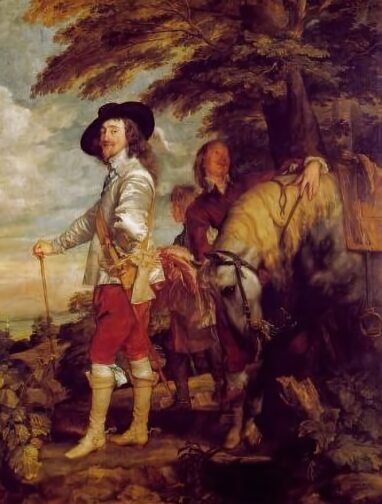
The child was placed in the care of Lord Fyvie at Dunfermline. When his father inherited the English throne in 1603, Charles was left behind in Scotland, possibly because he was not considered strong enough for the journey.
Charles was sent to England in August, 1604 and was placed in the care of Sir Robert and Lady Carey. Lady Carey prevented James I from having the string of the child's tongue cut, to bring on his speech and to have him placed in iron boots to strengthen his joints. The young Charles became determined to overcome these childhood handicaps and on the whole succeeded.
Charles, perhaps due to the many illnesses which marred his childhood, grew into a rather short man, at only five feet four inches high, with dark hair and the striking, brown, heavy-lidded eyes of many of his Stuart and Tudor ancestors. He much resembled his father but lacked his sharp intelligence. Charles was unconfident but possessed of a stiff and regal dignity.
Charles was created Duke of York, the traditional title of the monarch's second son but the death in 1612 of his popular and charismatic elder brother Henry Frederick, Prince of Wales, thrust Charles into the limelight as heir to the throne. James I, known to have a morbid fear of disease and death, did not attend his elder son's deathbed and Anne of Denmark was too distressed to do so. Charles mother died on 2nd March 1619. His father again avoided the deathbed, although Charles did not.
In an attempt to ally with Spain, Charles visited the Spanish court with his father's favourite Buckingham. He was said to be besotted with the Catholic Infanta Maria, daughter of the Habsburg King Phillip III, but his plans to marry her came to nothing. Baby Charles, as he was still referred to by his doting father, was welcomed back. James I, now 57, was drifting into senility.
Reign
Charles ascended the throne on the death of his father in March 1625. He married Henrietta Maria, the daughter of Henry IV of France and Marie de Medici. The marriage did not get off to an auspicious start, when the fourteen-year-old Princess first met Charles she nervously burst into tears. Henrietta Maria was dark like her Italian mother, Marie de Medici, strong-headed and inclined to meddle. Their wedding took place at Canterbury Cathedral on 12th June 1625.
The 3 eldest children of Charles I and Henrietta Maria, Charles, Prince of Wales, James, Duke of York and Mary, Princess RoyalCharles inherited the problems that had developed between his father and Parliament. In 1628 he was presented with a petition of rights, a major dispute over the matter was prevented by the assassination of Buckingham. Disagreement with Parliament resumed when the speaker refused to put forward three resolutions hostile to the King and was forcibly held in his seat while a vote was passed. Charles threatened to send in troops and dissolved Parliament for eleven years from 1629-1640.
In his grief at the murder of Buckingham, Charles I turned to his young wife and the marriage became closer. The first child of the marriage died soon after birth, but in the following year, 1630, the Queen was delivered of a strong and healthy son, who was christened Charles for his father. Although the Queen was a Catholic, their marriage agreement, while allowing her to practice her religion, decreed that the children of the marriage were to be brought up in the Church of England. The couple were to produce a large family.
Charles, a great lover of art, transformed the royal collection into one of the foremost in Europe, by purchasing work by Van Dyck and Rubens. Inigo Jones was also put to work on the royal palaces.
The Civil War
Resentment smouldered at the King's methods of raising money and his religious policy. His extending of a tax known as Ship Money became a major issue of contention, as this tax was previously levied only in the country's defence.
William Laud in stained glass
Religion created further dissension. Charles was strongly influenced by William Laud, who practised an authoritarian form of Protestantism. When Charles appointed Laud Archbishop of Canterbury, he made efforts to suppress Puritanism. Laud tried to impose a revised Prayer Book on Scotland, occasioning the Scots Covenanters to rise in defence of their religion.
The King lost the First Scottish War and was forced to call a Parliament to request funds for a second. Parliament would not oblige and defiantly refused the King's request. The indecisive Charles was urged by the Queen to dissolve Parliament and rule by force.
After a second Bishops War, the King, desperately short of money, was forced to recall Parliament in 1640. This assembly, referred to as the Long Parliament, was seething at Stafford. Charles, after much indecision and agonizing over the matter, gave way and he was executed. Charles was never to forgive himself for this act of betrayal of his loyal supporter and suffered a guilt complex about it for the rest of his life.
In 1641 the M.P. John Pym listed the King's transgressions in his 'Grand Remonstrance'. The indecisive Charles, urged on by his enraged and wilful wife, impeached Pym and four other members of parliament for high treason. In January 1642 he went to the House of Commons with armed troops to arrest the miscreants, but to quote Charles, "all the birds had flown" on his arrival. The King and the royal family were forced to flee from London. As matters continued to deteriorate, Henrietta Maria and her younger children were sent on to France.
Charles raised the royalist standard at Nottingham in 1642 marking the opening of the Civil War. His forces defeated the Parliamentary army in the first battle of the war, at Edgehill. In 1644, an obscure East Anglian landowner, Oliver Cromwell came forward to lead the Parliamentary forces and the New Model Army of disciplined, professional troops were trained. Cromwell was to prove himself a superlative general and at Naseby in Northamptonshire in 1645, won a decisive victory over the Royalists. Cromwell, Fairfax and Henry Ireton presented Charles with the Heads of Proposals by which he might remain King but with a written constitution. Charles was obstinate and procrastinating and negotiations broke down. In retaliation, the New Model Army then marched on London and took the capital.
Charles I at his trial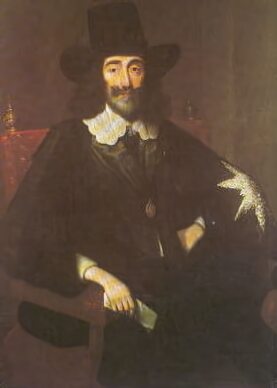
The Trial and Execution of Charles I
The King resorted to using the Scots against the Parliamentarians. The army was now demanding that "Charles Stuart, that man of blood" should be brought to account for his crimes against the people, the King of England was put on trial for his life.
Charles behaved with great dignity and courage throughout his trial, conducted at Westminster Hall. He defended himself ably and managed to control the stutter which had afflicted him all his life. He was sentenced to death.
In January 1649, King Charles I walked out of the Banqueting House at Whitehall onto a black-draped scaffold, before a hushed and aghast crowd of spectators. He wore two shirts against the cold so that he would not be seen to shiver, which his enemies might mistake for fear. The headsman took off his head with one blow and triumphantly held the gory and bloody symbol of royalist oppression aloft to the assembled crowds. England was now a republic.
Despite the establishment of the Protectorate under Oliver Cromwell, Royalists dated the reign of his son Charles II from the day of his father's execution.
Maria remained in Paris with their youngest daughter, Henrietta Anne Stuart, after her husband's death. At one point bringing up her grandson, the young James Crofts, later Duke of Monmouth, the son of the future Charles II and Lucy Walter.
She alienated her son Charles when she unsuccessfully attempted to convert her youngest son, Henry, Duke of Gloucester, to Catholicism. She returned to England after the Restoration in 1660 and lived at Somerset House until 1665. She eventually returned to France, founding a convent at Chaillot. Henrietta Maria died at the Chateau de Colombes on 10th September 1669 and was buried at St. Denis' Basilica, near Paris, amongst the tombs of the Kings of France.
After his execution, Charles' body had been interred in an unmarked grave in St. George's Chapel, Windsor. Due to the absence of a marker, there was much uncertainty about where Charles I’s grave was located in St. George's Chapel. It was finally discovered in 1813 when work was in progress to prepare a place for King George III’s future interment, the vault of King Henry VIII was breached. Seeing this as an opportunity to clarify where Charles’s had actually been interred George, the Prince Regent (the future George IV) decided to clarify the issue.
inspection of the grave was carried out on 1 April 1813, in the presence of the Prince Regent, Sir Henry Halford (President of the Royal College of Surgeons and physician to King George III and the Prince Regent), the Dean of Windsor, Ernest Augustus, Duke of Cumberland and others. Charles remains were enclosed in a lead coffin, containing a wooden coffin:-
The body had been wrapped in cerecloth. 'The left eye, in the first moment of exposure, was open and full, though it vanished almost immediately.' The king's head was carefully removed from the cloth, the stitches with which it had been reattached to the body had disintegrated. Charles' hair was found to be a lustrous dark brown and had been cut very short before his execution, the forked beard was a more reddish colour. Some of the hair from the back of the head, the beard, a tooth, and half of the severed fourth cervical vertebra were removed. The surface of the severed vertebra was perfectly smooth and even, 'an appearance which could have been produced only by a heavy blow, inflicted with a very sharp instrument.'
With this circumstantial evidence, as well as an inscription on the outside of the lead coffin, all present wherein agreement that these were the remains of Charles I. The coffin was then soldered up and the vault closed again. King William IV later provided a memorial stone.
Charles I imprisonment at Carisbrooke Castle
Charles, Prince of Wales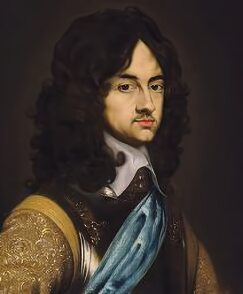
The Children and Grandchildren of Charles I and Henrietta Maria of France
(1) Charles James, Duke of Cornwall b. & d. 13 March, 1629.
(2) CHARLES II 29 May, 1630- 6 February, 1685 reigned May 1660- February 1685
Married Catherine of Braganza, the daughter of John II, Duke of Braganza and his wife, Luisa de Guzmán.
No legitimate issue.
Mary, Princess Royal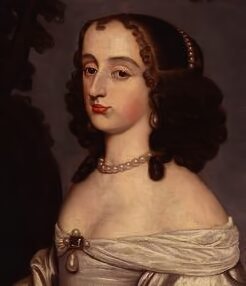 (3) Mary, Princess Royal 4 November, 1631-24 December, 1660
(3) Mary, Princess Royal 4 November, 1631-24 December, 1660Married William II, Prince of Orange, son of Frederick Henry, Prince of Orange, and Amalia of Solms-Braunfels.
Issue:-
(i) WILLIAM III, Prince of Orange, King of England, Scotland and Ireland. 4 November, 1650-8 March, 1702 m. MARY II, daughter of James II, his first cousin.
James, Duke of York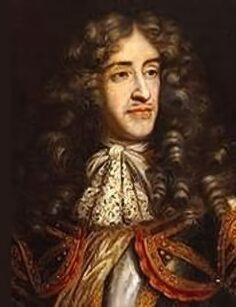
(4) JAMES II & VII 14 October, 1633- 16 September, 1701
M. (1) Anne Hyde.Issue:-
(i) Charles, Duke of Cambridge 22 October, 1660-5 May, 1671
(ii) MARY II 30 April, 1662-28 December, 1694 m. WILLIAM III
(iii) James, Duke of Cambridge 12 July, 1663-22 May, 1667
(iv) QUEEN ANNE 6 February, 1665-1 August, 1714 m. George of Denmark
(v) Charles, Duke of Kendal 4 July, 1666-20 June, 1667
(vi) Edgar, Duke of Cambridge 14 September 1667-15 November, 1669
(vii) Henrietta 1`3 January, 1669-15 November, 1669
(viii) Catherine 9 February, 1671-5 December, 1671
married (2) Mary Beatrice of Modena. Issue:-
(ix) Catherine Laura 10 January, 1675-3 October, 1675
(x) Isabella 28 August, 1676-2 March, 1681
(xi) Charles 7 November, 1677-12 December, 1677
(xii) Elizabeth b. & d. 1678
(xiii) Charlotte b. & d. 1682
(xiv) James Francis Edward, Prince of Wales 10 June, 1688-1 January, 1766
m. Maria
Clementina Sobieski
(xv) Louisa Maria Theresa 28 June, 1692-20 April, 1713
(5) Elizabeth 29 December, 1625-8 September, 1650
Elizabeth died of pneumonia on the Isle of Wight on 8 September 1650, while a prisoner of Parliament.
(6)Anne 17 March, 1637 8 December, 1640
(7) Catherine b. &d. 1639
Henry, Duke of Gloucester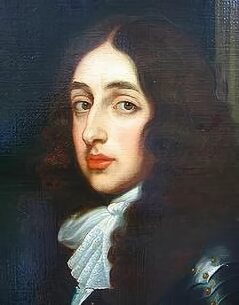
(8) Henry, Duke of Gloucester 8 July-1640-18 September, 1660
Henry, also known as Henry of Oatland, died at aged twenty one after contracting smallpox in the autumn of 1660, just after the Restoration, he never married.
Henriette Anne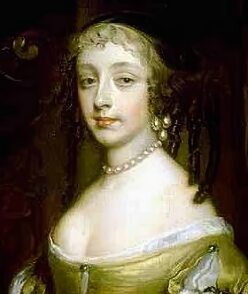
(9) Henriette Anne 16 June,1644-30 June, 1670
Married Phillip, Duke of Orleans, son of Louis XIII of France and his queen Anne of Austria.
Issue:-
(i) Marie Louise d Orleans 27 March, 1662-12 February, 1689 m. Charles II of Spain
(ii) Phillip Charles, Duke of Valois 16 July, 1664-8 December, 1666
(iii) Anna Maria d' Orleans 27 August, 1669-26 August, 1728 m. Victor Amadeus of Savoy
James I PreviousNext Charles II
